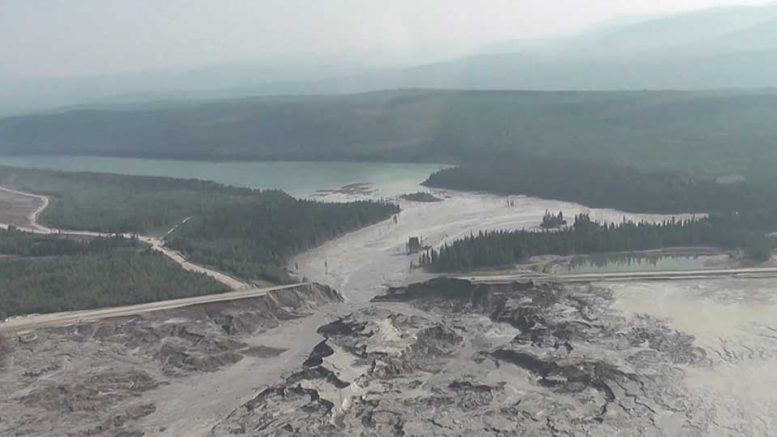In 2004, Imperial Metals (TSX: III) notified B.C.’s Ministry of Environment that it would apply for a water-discharge permit so that it could restart its Mount Polley copper mine near Likely, British Columbia.
The company said it would need to release water from a tailings pond, which would grow in volume once mining resumed operations.
Ten years later, it was still waiting for permission to discharge water when, on Aug. 4, 2014, one of the tailings pond embankments gave way — solving the water surplus problem in a most dramatic way.
The Mount Polley incident became one of B.C.’s worst mining disasters, spilling more than 20 million cubic metres of water and slurry into Hazeltine Creek, Polley Lake and Quesnel Lake.
Documents obtained by Business in Vancouver through a Freedom of Information request confirm that the company had warned a slow-moving government that “geotechnical instability” could result if pressure on the tailings pond dam was not relieved by discharging water, although it appears no one predicted such a catastrophic failure.
The documents also suggest the ministry did not appear to consider the matter all that urgent.
While an expert technical panel investigating the disaster concluded that water pressure did not trigger the dam’s failure, it exacerbated the damage due to the sheer volume of tailings water and slurry that flowed into fish-bearing streams and lakes.
In a separate investigation, chief inspector of mines Al Hoffman said in December 2015 that while Imperial Metals did not contravene any regulations, the company had “failed to operate using best available practices.” He cited “inadequate water management” as one of the problems.
Imperial Metals fired back by pointing out it had applied for a water-discharge permit in 2006. When it finally got one in 2012, it was so restrictive that it allowed for only one-tenth of the water that needed to be discharged. The company applied for an amendment and had been given the green light to start a pilot water-treatment project in December 2013, but was waiting for a new discharge permit when the dam collapsed.
So why did it take so long for the government to approve a water-discharge permit?
When provincial officials were either unable or unwilling to answer this question, Business in Vancouver filed a Freedom of Information request in January 2016, asking for documentation that might provide an answer.
It took the government a year to respond to Business in Vancouver’s request, with the release of 3,500 pages of documentation. The documents appear to reveal nothing particularly problematic with the application. If they reveal anything, it’s that the wheels of bureaucracy turn particularly slowly when it comes to getting anything related to a mine approved in British Columbia.
The Mount Polley mine, idle since 2001, was restarted in 2005, and in 2006 the company began seeking a water discharge permit, although it did not formally apply for one until 2009.
Since the water would need to be treated before it could be released into fish-bearing waters, the company began looking at treatment options. The company decided on a two-phase plan. Until it could get a longer-range treatment plan in place, it went with a stopgap measure to deal with an urgent water volume problem. It settled on reverse-osmosis (RO) treatment.
“It is something that we were considering to get us over the hump of needing to get water off the property, but would give us time to develop a better, long-term solution,” Steve Robertson, Imperial Metals’ vice-president of corporate affairs, told Business in Vancouver.
Minutes from a November 2013 liaison committee meeting show that Luke Moger, the company’s project engineer, warned that “water in the tailings storage facility will reach the point of geotechnical instability in two to three years, if not addressed.”
Before the mine’s restart in 2005, there were 1.5 million cubic metres of water in the tailings pond. It had grown to 7.6 million cubic metres by May 2013, and the company was forced to raise the dam’s embankments to prevent overtopping.
Above-average runoff and rainfall pushed it to 9 million cubic metres, and, in May 2014, the dam came close to being overtopped by water after a heavy rainfall.
Email exchanges suggest that the Ministry of Energy and Mines staff were aware of the concerns. But Environment Ministry staff seemed more concerned about water quality than quantity.
In a response to the company’s plan to use RO as a stopgap measure for treating water before discharging it, one ministry staffer questioned the plan: “Holy cow! RO? What has precipitated this decision and why are they in such a rush? This is a super-expensive technology with lots of issues with brines.”
Environment Minister Mary Polak could not be reached for comment, but the ministry makes no apologies for taking its time.
“In the interest of public health and safety, ministry staff must ensure a permit application is not rushed through without gathering the appropriate expertise to make an informed decision,” ministry spokesman David Karn said in an email.
After the dam burst, the RO treatment was no longer needed. The company has since repaired the tailings pond, the mine is back in operation and it has opted for a different water-treatment system.
But the company still needs a water-discharge permit, and it’s waiting to get one.
This story was originally published in Business in Vancouver:
https://www.biv.com/article/2017/1/mining-disaster-followed-years-permit-delays-docum/
 — Based in Vancouver, Nelson Bennett is a reporter at Business in Vancouver, where this article first appeared. Visit www.biv.com for more B.C. business stories. Glacier Media is the parent company of Business in Vancouver and The Northern Miner.
— Based in Vancouver, Nelson Bennett is a reporter at Business in Vancouver, where this article first appeared. Visit www.biv.com for more B.C. business stories. Glacier Media is the parent company of Business in Vancouver and The Northern Miner.


Be the first to comment on "Imperial’s Mount Polley disaster followed years of permit delays"